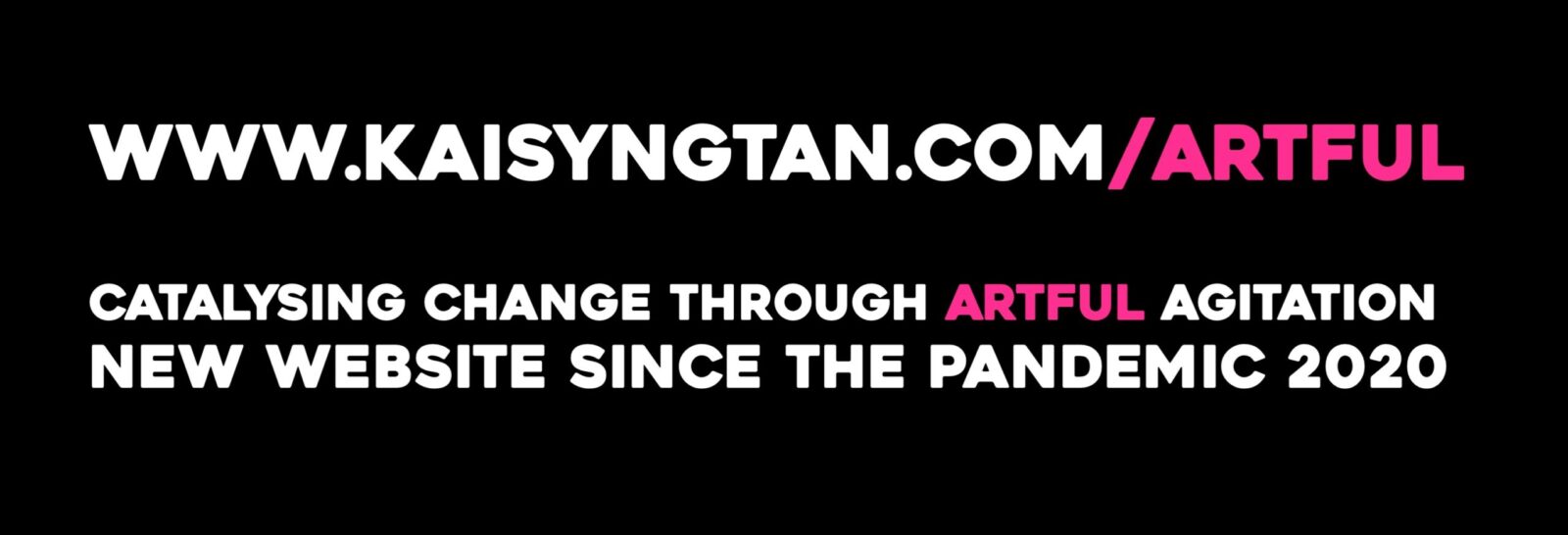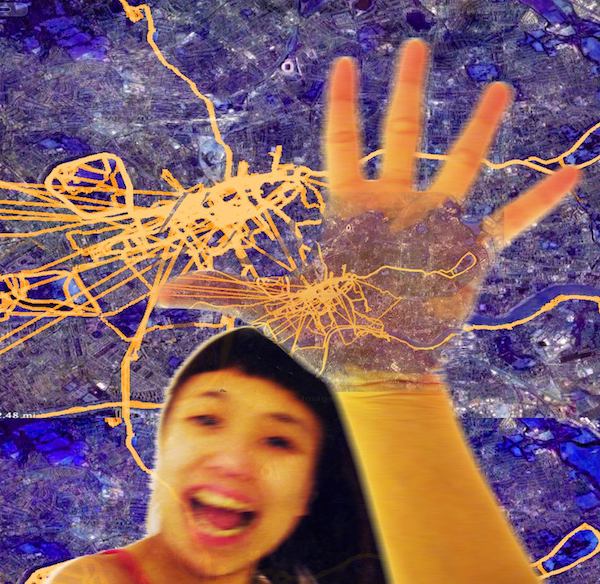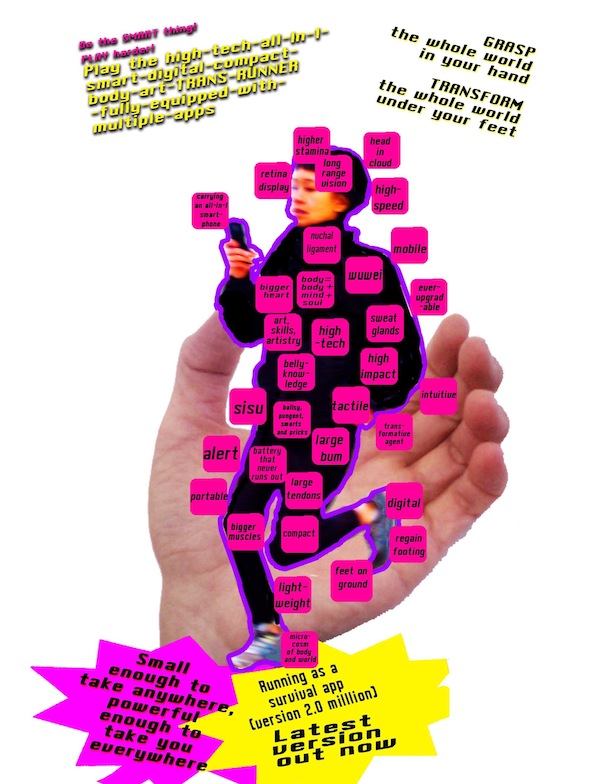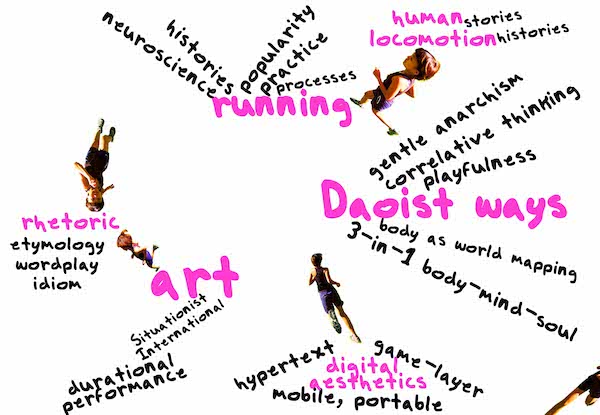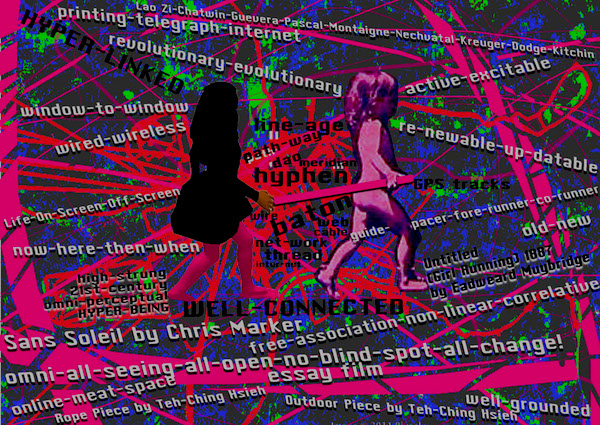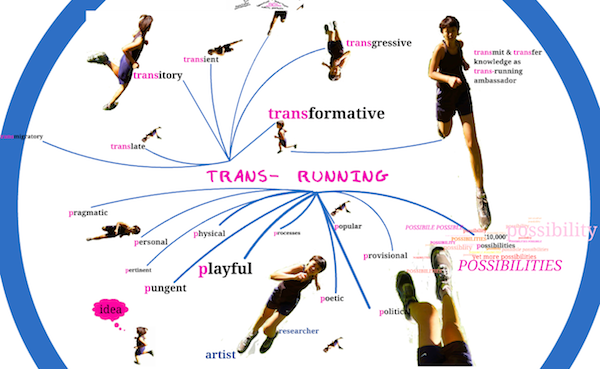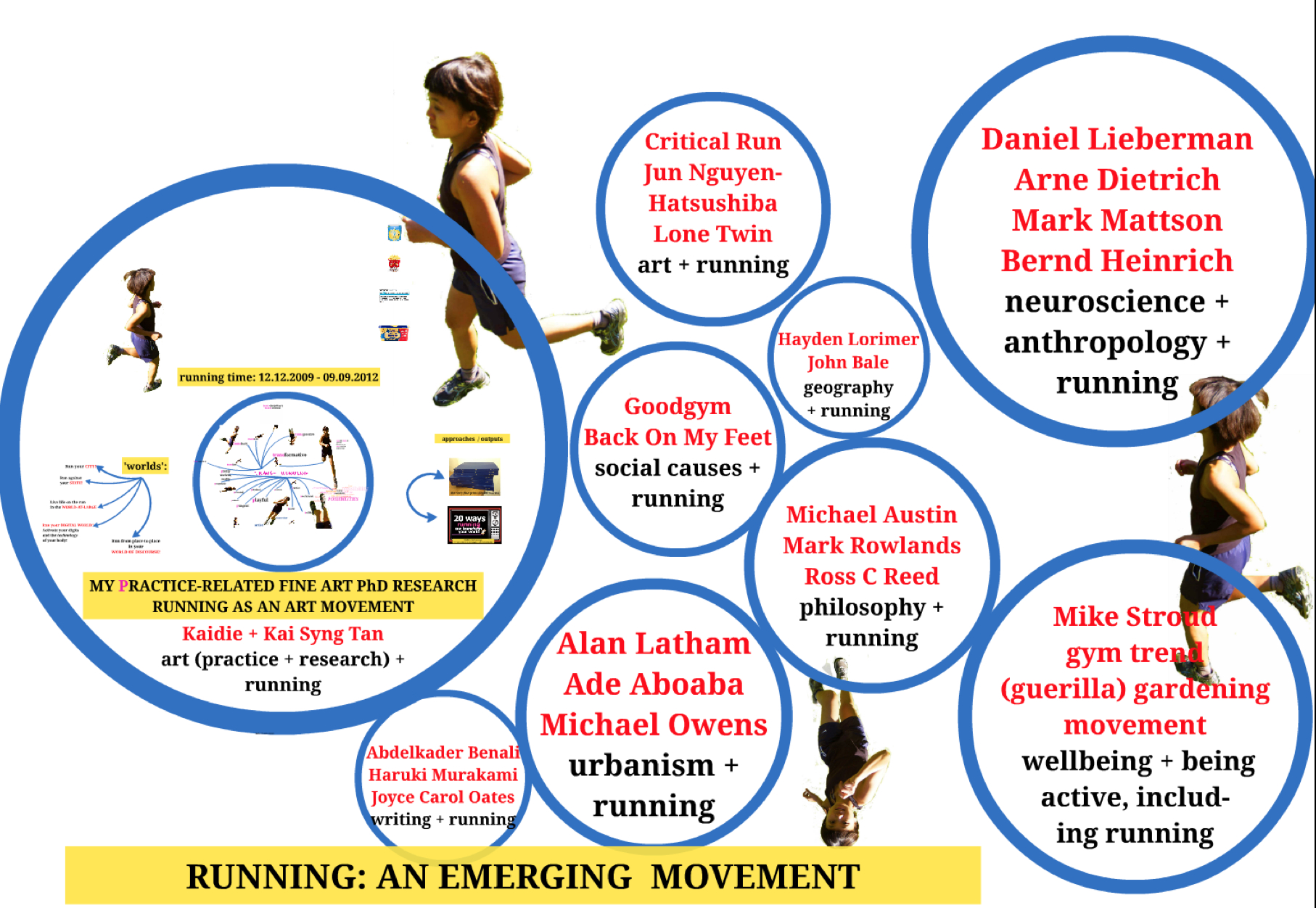On the (f)art of running: the art, fine art and (outbursts of) fart(s) of running. Running as an art movement: playful + performative + poetic + political + personal + philosophical+ process-of-thinking + practical + phantastical + pragmatic + pungent + pertinent. Possible outcomes: *research *book *artworks in the form of ‘running discourses’, film, performance, installation, etc etc * as YOUR PERSONAL TRAINER cum LIFE COACH!! Yes! To guide you on the physical-poetic-playful-pungent-pragmatic-phantastical ways to run your world!! *app, *festival et al Possible contexts: *academic *artistic *health and wellbeing *urban studies *creative thinking *happiness studies *digital art *sports. Running time: now till I run out of breath/time. * Read about my PhD research that explores running within an artistic framework here. * Discourse + networking + merry-making + endorphins: Join me in the world’s first ever Festival of Running, 26 June 2014.
Come join me in my running art movement!
Feel lost in the city, physically and metaphorically-speaking? Fancy flanuering and dériving – but getting a tad tired of walking – and can’t quite afford the wine, hashish, opium or heroin that the 2 Charles (Baudelaire and Dickens), Coleridge and Debord resorted to to enable them to walk on the wild side (rest in peace, Lou Reed!)? Had enough of the 10,000 CCTVs in London shadowing your every move? Sick of being seen as an Other? Run out of ideas to fend off sexual harassment?? Refuse to toe the party-line or to take things lying down? Tried sit-ins, walk-outs, hunger-strikes and topless protests – but need something more poetic, less direct, and that which can keep you out of jail (especially if it is illegal for more than 5 people to assemble in the public area!!)? Curious about parkour and skateboarding as urban tactics to re-assert your autonomy, but bit flabby and not quite fit enough (from all those years glued to your chairs in your ivory towers)? Feeling restless like Pascal when trapped in a small room? Driven mad by the monotony of daily life like Chatwin? Feeling un-fit for life from your sedentary lifestyle? Feel like Pavlov’s dog in the technology-saturated digital age? Trapped under the consensual hallucination? Cannot stand the prowling eyes of the Big Brothers and Big Bosses online? Exhausted by having to plough through all those heavy books and abstract discourses? Nauseated by highfalutin types who are territorial and fearful of those who trespass? Want to feel high, free and happy?
Run, and re-map your body with the city, state, digital world, world-at-large and your thinking! Run, and register as nothing but a blur under CCTV cameras! Run, and stick 2 fingers up at the male spectators! Run, and run against the authorities like Colin of the Loneliness of the Long Distance Runner! Run, and let your imagination run riot! Live life on the run, and constantly challenge yourself, and have a revolution of your everyday life! Run, and change your fate like Lola of Run Lola Run! Run and re-embrace your digits of your fingers and toes, and playfully subvert the digital world! Run, and get back in touch with your belly-knowledge/intuition (wuwei) out-wit the too-clever machines! Run, and re-wire your brain, and increase your stamina so that you are as compact as, and can last even longer than the latest smartphone! Run, and get high, and run into creative insights like Joyce Carol Oates! Run, and freely correlate ideas like the hypertext and subvert hierarchy, linearity and logic. Run, and think against the way you normally think, and the way society thinks and wants you to think! Run, and be anarchic like Abdelkader Benali and George Sheehan. Run, and run from place to place, and generate discourse – after all, the Latin origin of discourse, ‘discursus’, refers to the running from place to place. Run, and be like the historical running ambassadors who were forerunners in both the literal and metaphorical senses of the word. Run, and run your world!
Contexts
There are theses/libraries/departments/schools/websites chokeful of studies about walking. We know about Benjamin, Li Bai, Wordsworth, Rousseau, Will Self, so on, and so forth. When it comes to the ‘art world’, we are familiar with the practices of and writings about the Situationists, Richard Long, Janet Cardiff and Francis Alys, just to name a few. Since the 1970’s, the world has experienced what British runner Sir Roger Bannister calls a ‘running boom’ (cited in Newsholme & Leech 1983, p.vi). The London Marathon welcomes nearly 40,000 runners annually (The London Marathon Limited 2013). Worldwide, a marathon held daily, and Palestine held its first – named Right To Movement – last year. Lest you thought that this was a passing fad, think again, for we have run for 2 million years. Our ancestors ran for up to 6 hours across 20 miles to hunt for food (Liebenberg 2008). After all, human beings are ‘born to run’ long distances (Bramble & Lieberman 2004), endowed as we are with unique physical attributes – as well as an indefatigable ‘ability to dream far ahead’ (Heinrich 2002 p.177). In other words, running has the potential to be worked through not just as a physical process but a poetic one, and not only as a subject matter but methodology and practice, not just as an activity/verb but a concept/noun. Running may even give the cultural tradition of walking a run for its money, given how the activity can be conducive to creativity. For one, Alan Turing was said to have invented the computer in the middle of a run (Burfoot 2007). Then, given our technology-saturated reality, what better counterpoint than running? Indeed, the ‘digital’ can also refer to our bodily ‘digits’ – that of the toes. And who can forget feisty ‘Lola’, who ran and transformed her fate in the film Run Lola Run (Tykwer 1998), or Colin of The Loneliness of the Long Distance Runner, for whom running is a political act? Still unconvinced? Run through the OED, and you will find no fewer than 81 definitions and conjugations for the word ‘run’ – which run across 14 pages (Simpson & Weiner 1989, vols.XVI, p. 250–264). In fact, the Latin etymology of ‘discourse’ refers to ‘running from 1 place to another’ (Blackburn 2008 p.102). So much to mine/dig/tease out/unpack/explore! No wonder in the past decade, philosophers, novelists, geographers and neuroscientists have been harnessing running in their discourses (Austin 2007; Murakami 2008; Latham and McCormack 2010; Mattson 2012). Yet, hitherto, a systematic study of the physical and poetic possibilities of running by artists and/or art researchers appears to be missing. The art world seems to be slow to capitalise on running as subject matter, and/or medium. And then you have the noisy and unfit armchair critics like Zizek, Baudrillard and Finkielkraut who mock running.
PhD practice-related research 2009-2013
From the period of 2009-2013, as a University College London and National Arts Council (Singapore) scholar, I worked on a practice-related Fine Art thesis at the Slade School of Fine Art, with the objective of taking the first step to help to fill in this gap. My intention was to help contribute towards introducing running as a topic and creative approach to the art world, so that artists, curators, art writers and thinkers may explore it in their practice and/or research. The thesis itself may be understood as an example of how running may function as a rewarding field of study to a researcher who is also an artist. Synthesising rigorous research with dynamic art practice, my work examines some of the physical and poetic processes of running, and proposes that running may be mobilised as a playful medium to re-orientate the way we relate to the world today. I named my ‘new’ way of running ‘trans-running’. A concept as well as an action, trans-running concerned both the physical and poetic processes of running, and running as both subject matter and approach. Trans-running aimed to be a playful medium to re-orientate the way we approach our real and digital worlds, as well as our world of thinking. Nourished by the wisdoms of the ancient Chinese tradition of Daoism (Taoism), the philosophy of correlative theory, digital aesthetics, neuroscience, rhetoric (with the activation of run-related idioms) and so on, trans-running aimed to be a visceral counter-strike as well as a euphoric celebration of our complex conditions today. In order to demonstrate that running may indeed have the potential to function as a playful methodology, I self-reflexively activated running as an approach in my 70,000-word written thesis, by ordering my arguments and presenting my artworks in a playful manner that was inspired by running and the runner’s high. Trans-running aimed to be trans-cultural, trans-disciplinary, transgressive and transformative. I encouraged my audience/reader to perform trans-running when approaching the thesis. I invited them to regard my work as a template of how they can approach running as a concept and action, subject matter and approach. I beckoned them to run back-and-forth between the artworks and written thesis, and between the causal and correlative modes of writing in my written thesis. I even coaxed them to edit my discourse, and formulate their own mapping of trans-running with which they may transform their world. To walk or rather run the talk, I generated primary research/field work in the form of a large body of studio practice collectively entitled Kaidie’s 1000-Day Trans-Run 12.12.2009 – 09.09.2012. This included my blog which generated more than 1.3 million unique visitors across the period of 4 years. I performed ‘Nondon’ (a supercharged variation of the greatest city on googleearth, London)-based ‘Kaidie’ (a kind of a nuclear-fuelled version of me), and picked up running as a sport and durational performance. Along the way, I completed 9 races (including the 2011 London Virgin Marathon) and raised money for charities, and exhibited/performed/screened/spoke at 63 exhibitions/conferences/interviews.
Potential impact
I aimed for this work to function as a call for action as it alerts artists and art researchers to tap into the rich resource of running, by offering an introductory survey of the physical and poetic possibilities of running. I likened my role to that of a ‘running ambassador’ or a ‘forerunner’ of running in the art world. I explored a broad range of points through running; I explored running through diverse areas, too. I wanted to raise questions, and tease out or open up a new pathway in the art world. As artists and art researchers re-assess and capitalise on the potential of running, they can hence join in the emerging discourse about running with practitioners and researchers in other disciplines who are already studying running. This engagement is arguably timely, given how running is gaining momentum as an activity as well as an area of study. This ‘running movement’ may be contextualised with other emerging critical concerns such as that of the obesity crises, as well as trends such as the fitness craze and community gardening.
Not run-of-the-mill!
An additional observation: there is arguably a paucity of research from non-Western female researchers who offer interesting points-of-views on running. A related point is how I observe that thus far, existing discourses seem to privilege a Western, male perspective. Hence, another intention that I had with my thesis – a playful analysis of running via a unique blend of art practice and research that re-contextualised non-Western and non-canonical sources – was that it could contribute a refreshing voice to discourses on running and running-related issues. In the long run, perhaps practitioners and researchers from different worlds may even consider running as an ‘art movement’, in both senses of the word ‘movement’!
Post-doc
Carry on running. And have even more fun. Running changed my world. It has empowered me as an artist, thinker (or rather person who uses her brain every now and then), urbanite, woman, writer, educator, person, 21st century person etc. I navigate the or rather my world with a child-like audacity and authority, freed from any brusiedboundbloodied chinese feet, freed from being ‘a great way to fly’ like the girls of the famous airline company. Running is my visual statement, my soapbox from which I shout: ‘Stop running my life! Stop running my world!’ I run, to assert my autonomy, to run my world as I stick 10 sweaty toes up at the snoopy state. I live my life on the run, to check my own complacency. I remain un-settled, fidgety like a toddler, like the Old Child of the Chinese philosopher of Lao Zi, like Michel de Montaigne’s traveller, and like J J Clarke’s intercultural person who subjects themselves to differences, to change, so that novelty becomes the norm. Thinking in a manner as if I am running, and more specifically, as if I am on a runner’s high, crossing boundaries and freely mixing-and-matching ideas freed me from the tyranny of the linear page and the oppression of abstracthighfalutinsnobberypretendintellectualism. Running has made me happy, or rather far less unhappy (most of the time), and given me the permission to (try to) embrace (a semblance of) happiness. To be sure, not moving, staying put, and melancholy and depression can be profitable. Xavier de Maistre, Vincent Van Gogh, Virginia Woolf and even, or rather, especially Pascal can attest to that. And of course, one of my favourite persons on earth and beyond, Samuel Beckett, is all about being stuck, being still. My own army/harem/factories/industrialsizedpacks of black dogs (of all shapes and sizes – St Bernard’s, silly chihuahuas, ridic poodle pups, sturdy bulldogs) and cats for that matter if it matters have been the driving forces for my creative output alllllllllllll my life (and I had been quite prolific or rather compulsive in my production…) (and nobody’s saying anything about the quality of the work made). Nonetheless, surely there is room in this (art/academic/general) world of ours to explore the physical and poetic processes of running and the runner’s high. Because (here goes the grandious declaration/call for action/actually to sound more militant and dangerous and exciting lets call it a WAR CRY) (drumroll) running has so much mileage.
Well, don’t just sit there and take my word. Get up and give it a go. Go on.
My very rough, ongoing map of researchers working on running. (Not to scale, sizes are random, and the circles should overlap.)
